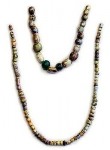 Archaeologists excavating Glencurran Cave in Burren National Park in County Clare, Ireland, have uncovered an unexpected treasure: a 1,150-year-old Viking necklace. It’s surprising because the piece is highly valuable so must have been treasured by its owner, but Vikings never settled in the Burren area.
Archaeologists excavating Glencurran Cave in Burren National Park in County Clare, Ireland, have uncovered an unexpected treasure: a 1,150-year-old Viking necklace. It’s surprising because the piece is highly valuable so must have been treasured by its owner, but Vikings never settled in the Burren area.
Some smaller, less significant Viking bead necklaces have been found in burials in Dublin. Nothing as glamorous as this, though.
[Excavation team leader Dr. Marion Dowd] said: “The necklace is the largest Viking necklace to have been found in Ireland. Normally, Viking necklaces that have been found have five to six glass beads, but this has 71 glass beads covered with gold foil.”
A leading expert on Irish cave archaeology, Dr Dowd said: “It is really bizarre how this necklace from a high-status Viking came to be in a cave in the Burren.
“There is no parallel for it in Ireland and it is puzzling on a number of fronts.
“The necklace would have been imported into Ireland from Scandinavia in the late 9th and early 10th century.
“Small numbers of these beads have been found with Viking burials at Kilmainham, Dublin, but nothing like the number found in Glencurran Cave. Such necklaces were worn by high-status Viking women and they might denote a woman’s cultural and religious affiliations. These were certainly prestigious items.”
Dr. Dowd speculates that the necklace might have come via Limerick. There was a Viking settlement there, so they may have traded with the Gaelic inhabitants of Burren.
Glencurran Cave has produced other finds in the 6 years since excavations began making it an archaeological gem even before actual jewelry was discovered. The current team has also found the skeletal remains of a two to four-year-old Bronze Age child, placed in the cave about 3,500 years ago, which is currently undergoing DNA testing. In addition, they’ve found the remains of seven adults, two other young children and one baby, plus the 10,000-year-old scapula of a bear.
I’m a little confused by their confusion. Even if Vikings hadn’t settled the area, why wouldn’t trade or a high status slave be a logical assumption?
There are just no other necklaces like it in all of Ireland. You’d think if you were out to find such a rare piece, you’d increase the odds considerably if you looked in an area where many Vikings converged. Instead they found it in a place where there weren’t any.
It’s definitely not something a slave would own. I’m not sure what the hierarchy of slavery was in Viking culture, but such a valuable item in all probability belonged to a wealthy woman.
I suppose what I meant about the slave was that it was a wealthy Viking woman who had become a slave. It’s a stretch I know, but interesting to imagine! I wonder if they know what the community there was like, its wealth, production, etc – maybe they produced something in that area that was of significant and therefore worth trading for a rare necklace?
Ohh, I see what you mean now. Hmm… I suppose it’s possible, although I tend to think of the Vikings as taking the slaves rather than being taken. I’m not well-informed enough about the Viking presence in Ireland to say.
The Burren area is a karst landscape. There’s very little water, very little wood, but lots of exposed limestone and rich grass growing between it, good for cattle grazing. Maybe they traded some quality Irish beef for that necklace.
Viking slaves? I have never heard of such a thing. Think about it. Who rowed the ships for the Romans? Slaves. Who rowed the boats for the Vikings? Vikings!
There wasn’t any inter-Viking warfare that resulted in enslavement of the losers?
Irish priests were traveling to Iceland at a time when the Vikings were accepting Christianity. Maybe one of the Vikings gave the necklace to a priest as an atonement for ransacking a monastery. Just a thought.
Aw, what a sweet Viking pillager. :giggle:
Vikings had a caste system that included three main classes: aristocracy, bondi or carls (average people) and a servant or slave class called “thralls” which could be prisoners of war, foreigners kidnapped during raids, or other Norsemen who owed a large debt or were convicts. Thralls were allowed to own things of their own, viking society did not look well on their mistreatment, and (in theory) they could earn the money to buy their freedom. We have to remember that this is in the age of serfdom in other countries – another class which is not called a slave class, but serfs weren’t allowed to own anything (as everything belonged to the king), were treated as their lords wished, and worked backbreaking hours for little reward. Most societies had some type of slavery or another, they just may not have called it that.
http://www.vikinganswerlady.com/thralls.shtml
Serfs were allowed to own things. They were bound to the land and had no freedom of movement, but they could still own personal possessions and even property, although of course the latter didn’t happen very often.
Thank you for the link. It confirms that in all likelihood the necklace did not belong to a Viking slave.
Why not a gift for royalty in exchange for settlement (even if not same local) or other reason? Question I have is how was the necklace found in situ?